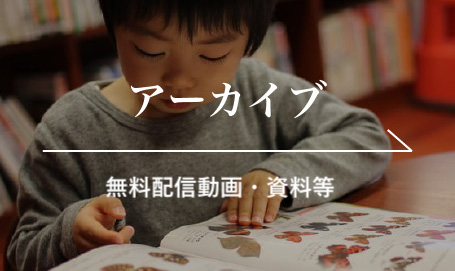Author(s): Yasuhiro Watanabe.
Title: A Historic Study on “the Continual Criticism and Restructuring” of the Childcare Schema through the Organized Workshop: An Analysis of the Formation Process of the Age-based Childcare Aim and Contents of All Public Day Nurseries in a Certain Local Government
Research on Early Childhood Care and Education in Japan, 2014, 52(1), 6-18.
Abstract: This study analyzed the annual reports of the childcare workshop of a certain local government and examined the role that this workshop carried out for the creative development of a childcare schema historically. As a result, the following points became clear: ① The childcare schema (the age-based aim and contents) was an opportunity
to develop the organizational practice, but it was an opportunity to limit it. ② This workshop had been “the learning system conducive to continual criticism and restructuring of the schema”, ③ The nursery workers became able to foresee new childcare scheme by examining the example of “the problem child” with other workers, ④ They raised the quality of their own physical and emotional care labor and formed “the warm interpersonal network” which protected the children.
Keywords: learning system,schema,aim and contents,problem child,warm interpersonal network
—————–
Author(s): Tomomi Sakakibara.
Title: Teacher Support for 5-Year-Old Children’s Mathematical Understanding: Naturalistic Observations in Japanese Preschools
Research on Early Childhood Care and Education in Japan, 2014, 52(1), 19-30.
Abstract: TThe present study was aimed at investigating preschool teachers’ support for 5-year-old children’s mathematical understanding by examining types and frequency of mathematical activity practiced in preschools, as well as details of the teachers’ support in such activities. Ten preschool classrooms were observed for a total of 20 days. As a result, no activities focuses on teaching mathematics were observed. However, teachers’ behaviors to support children’s mathematical understanding were found fairly frequently in varieties of activities in which teachers’ goal was other than teaching mathematics. Teachers embedded mathematics in everyday activities, for example, by letting children collect certain number of materials when creating art projects, by asking the number of children who were present in the classroom when taking attendance, and by introducing children games that require the use of numbers.
Keywords: mathematical understanding,preschool activities,naturalistic observation,preschool teachers,young children
—————–
Author(s): Machiko Tsujitani.
Title: Young Children’s Telling Norms to Their Classmates and Their Peer Relations of Exclusion/Inclusion
Research on Early Childhood Care and Education in Japan, 2014, 52(1), 31-42.
Abstract: This study aims to observe the relationship between how preschool children show norms to each other, and their exclusion and/or inclusion in peer relations. Communication among four- to five- years old children was observed at a kindergarten. This study focuses on two girls (Ichika and Anna) and their communications with other children. Ichika was often taught norms by classmates, and in contrast, Anna often told norms to classmates. Analysis of the observation notes suggested that one’s breaking rules leads her to be excluded from classmates, while telling norms to others lead to sharing them among children. The notes also suggest that shared norms lead to prejudice such as “She cannot keep the rules”. However, it was found that these relationships changed over time, and by seeing Ichika as a child who needed help, the relationship transformed to inclusion.
Keywords: norm,exclusion,inclusion,peer-relation
—————–
Author(s): Sakiko Sagawa.
Title: A Case Study of How Children Share “Motifs” in Their Creative Process: Focusing on Children’s Body Positioning and Their Gaze
Research on Early Childhood Care and Education in Japan, 2014, 52(1), 43-55.
Abstract: This study aimed to clarify how 4-year-old children share motifs with other children in their creative play Participatory observation was conducted in 8 kindergarten classes of 4-year-olds and 5-year-olds, respectively, for 6 months. Both children’s body positioning and visual interactions were analyzed. The analysis revealed that children first moved next to other children, gazed at the other children’s creations, and showed the other children their own creations. In other words, their gazes crossed at close range. After this, they directed their utterances about their motifs not only toward adults in the vicinity, but also towards other children, indicating that the motifs were shared between the children. Finally, children appropriated the others’ ideas to make their own creations in collaborative creative play.
Keywords: creative play,motifs,body positioning,visual interaction,4 year-olds
—————–
Author(s): Kumiko Ikeda.
Title: A Case Study of the Formation and Development of Peer Relationships of a Child with Special Needs: Focusing on the Body Movement
Research on Early Childhood Care and Education in Japan, 2014, 52(1), 56-67.
Abstract: In this study, the process of developing peer relationships of a child with special needs was examined. A developmentally delayed 4-year-old girl was the subject of this case study research. Data were obtained through participant observations conducted for 18 months in a kindergarten. This study examined observational data, focusing on the body movement as a base of communication. The results show: (1) the child with special needs made a base of peer relationship with other children by imitating the same posture as others do or through mimicking each other reciprocally. (2) Spending time together in the same class, they communicated through their bodies. As a result, a relationship between them has become very intimate and consequently they communicate with all their hearts.
Keywords: a child with special needs,peer relationships,the body movement,case study
—————–
Author(s): Maiko Hirano.
Title: The Process of Children’s Growth in Preschool Clean-up Scenes: Focusing on “Contradicting Human Natures within a Self”
Research on Early Childhood Care and Education in Japan, 2014, 52(1), 68-79.
Abstract: This study aims to examine the experiences and growth process of children in clean-up scenes. We observed a three-year-old boy in diverse clean-up scenes and recorded them for a year. The episodes were analyzed in terms of “Contradicting human nature within a self” which is the technical term by Takashi KUJIRAOKA. The child’s behavior in the scenes kept changing. We believe that these changes were part of his growth process, which involved a balance between “Contradicting human natures within himself”. He developed various relationships with others (preschool teachers and other children) and experienced swaying and contradiction. In this paper, we shed light on the three-year-old child who tried to balance between “Contradicting human nature within himself” and on the significance of the clean-up scenes for children.
Keywords: clean-up scenes,growth process,a three-year-old child,Contradicting human natures within a self,swaying and contradicting
—————–
Author(s): Yoshihiro Tanaka, Hiroyuki Ito, Wataru Noda, Nobuya Takayanagi, Shin Harada, Naoto Mochizuki, Satoko Ohtake, Masatsugu Tsujii.
Title: Predicting Children’s Adaptation and Maladaptation in Elementary School by Using the Nursery School Teacher Rating Developmental Scale for Children-Revised Version (NDSC-R)
Research on Early Childhood Care and Education in Japan, 2014, 52(1), 80-89.
Abstract: This study investigated the effectiveness of the Nursery School Teacher Rating Developmental Scale for Children-Revised Version (NDSC-R) to predict children’s adaptation and maladaptation in elementary school. There were two kinds of data available for 783 children in 2 cohort studies: the NDSC-R, completed by nursery school teachers, and the Strengths and Difficulties Questionnaire (SDQ), completed by elementary school teachers. The SDQ of the first cohort study (414 children) was conducted in the first grade and the SDQ of the second cohort study (369 children) was conducted in the fourth grade. Multiple linear regression analyses and risk analyses indicated that subscale scores of the NDSC-R were predictive of each subscale scores and the total difficulties score of the SDQ in first grade and fourth grade.
Keywords: Nursery school child records,Nursery Teacher’s Rating Development,Scale for Children-Revised Version (NDSC-R) Strengths and Difficulties Questionnaire (SDQ),Longitudinal study
—————–
Author(s): Yuki lino.
Title: A Study on Creating Process of New Zealand Preschool Unified Curriculum, Te Whariki: Through Interviews with Relevant People
Research on Early Childhood Care and Education in Japan, 2014, 52(1), 90-104.
Abstract: The purpose of this study is to illustrate the creating process of Te Whariki from an interview with the creators of Te Whariki which was created as a unified pre-school curriculum in New Zealand in 1996. Previous research clarified that Te Whariki was created in collaboration with the representative of the Maori and European New Zealanders. In addition to the two representatives, this research examined the creation process of Te Whariki from three directions by carrying out interviews with the New Zealand administration officials. As a result, it became clear that, in the creation process of Te Whariki, the Maori side took the lead and that the European sense of values were included. This research found out that it is a different fact from a view taken by the former research results.
Keywords: Te Whariki, Curriculum, New Zealand
—————–
Author(s): Kanami Kamide, Masako Saito.
Title: Investigation of the Expertise of Caregivers in Pediatric Wards: Interviews of Specialists for Care and Education in Pediatrics
Research on Early Childhood Care and Education in Japan, 2014, 52(1), 105-115.
Abstract: The aim of this study was to investigate the expertise of caregivers in pediatric wards through interviews of the specialists who work in pediatric wards as caregivers. Ten specialists for care and education in pediatrics participated in this study. Results of the interview of the specialists were analyzed by hierarchical cluster analysis. The results of the analysis indicated that the expertise of caregivers in pediatric wards were to have a firm awareness as a medical team member, and to be able to communicate and discuss with co-medical staffs from the view of care and education in the nursery, and contribute to enhancing the quality of life in children with a disease. nursery in pediatric wards, specialists for care and education in pediatrics, expertise, hierarchical
Keywords: nursery in pediatric wards,specialists for care and education in pediatrics,expertise,hierarchical cluster analysis
—————–
Author(s): Makoto Nakane.
Title: The Actual Conditions and Issues on Work-Life Balance of Day Nursery Teachers: Focusing on ‘Difficulties’ in Their Consistent Lives
Research on Early Childhood Care and Education in Japan, 2014, 52(1), 116-128.
Abstract: The purpose of this paper is to analyze and to consider Work-Life Balance of day nursery teachers, especially `difficulties’ in their consistent lives. The author interviewed seven day nursery teachers who were nurturing their children under 12. The results reveal that there were various situations among four conditions: independency, place of work, family, and social resources. The author analyzed their results taking into account both factors to promote and interrupt their continuous working lives. In conclusion, ‘difficulties’ in their continuous working and consistent lives are dependent on their situations among motherhood consciousness, place of work, family, and social resources.
Keywords: Day Nursery Teachers,Work-Life Balance,Difficulties’ in their consistent lives
—————–









